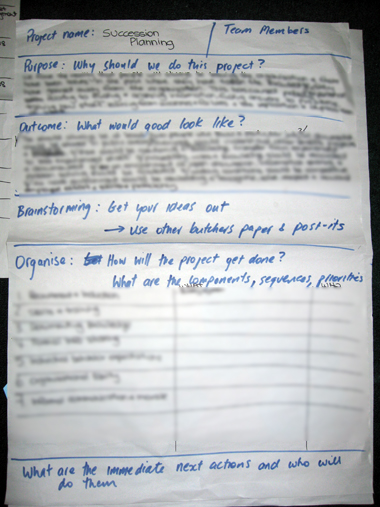Blog
Subscribe
Join over 5,000 people who receive the Anecdotally newsletter—and receive our free ebook Character Trumps Credentials.
Categories
- Anecdotes
- Business storytelling
- Collaboration
- Communication
- Corporate Storytelling
- Culture
- Decision-making
- Employee Engagement
- Events
- Fun
- Insight
- Leadership Posts
- News
- Podcast
- Selling
- Strategy
Archives
- March 2024
- December 2023
- November 2023
- October 2023
- September 2023
- August 2023
- July 2023
- June 2023
- May 2023
- April 2023
Years
Space and tools impacts thinking
We’ve been running a series of knowledge strategy projects for natural resource management regions across Australia. The activities culminate for each region in a two day workshop where participants design a set of projects and interventions to improve their knowledge environment.
To guide people through a process of designing their projects we divide up a sheet of butcher’s paper (also called flip-chart paper) into steps for small teams to work on to help them plan their project. I’ve noticed that the way we divide up this paper and the tools we provide seems to have a big impact. This is not evidence nor proof, just an observation.
Here is an example of one way I’ve divided up the paper and what the small group of participants wrote.

Now here is another example where I provided a much larger space for brainstorming (a separate page) and suggested they use post-it notes to capture their brainstorming ideas. We also gave them finer tipped felt pens.

Their ‘Organise’ section spilled over into another sheet of butcher’s paper plus there was yet another sheet dedicated to brainstorming. This change toward more detail seems to hold for all the groups in the workshop.
It seems people will fill the space you provide and as a result the second group engaged in a more rigourous and deliberate thinking. Mind you, it could have just been the people in the room.
Technorati Tags: facilitation
About Shawn Callahan
Shawn, author of Putting Stories to Work, is one of the world's leading business storytelling consultants. He helps executive teams find and tell the story of their strategy. When he is not working on strategy communication, Shawn is helping leaders find and tell business stories to engage, to influence and to inspire. Shawn works with Global 1000 companies including Shell, IBM, SAP, Bayer, Microsoft & Danone. Connect with Shawn on:
Comments
Comments are closed.
From my experience, it’s not just the people in the room.
Try this little experiment: Take either your left or right hand and lift it as high it can go. Now lift it a little higher.
Everyone I’ve asked to do this experiment has been able to get their hand a little higher. Some even just stand up, or climb onto a chair. Why didn’t they follow my initial request? Because we all place some limit on our response.
If we are not given a framework to move in, we self impose one. With you setting the framework (indirectly and unstated) the participants will naturally assume that’s the ‘correct’ frame (usually) and work with it.
I’m curious though, what would happen if you let the participants set their own space?
Good point Michael and I like your experiment.
BTW I have tried letting the participants set their own space. It was when I asked them to write a story to explain how they got here in relation to some aspect of their business. They didn’t know what to do. From that point on I have been providing a framework – a story spine – and it has worked well.
Hello Shawn:
Please help me understand. I’m clear that you gave scope for brainstorming in the second exercise. Did you encourage brainstorming in the first exercise? Once I’m clear on this, I’ll give you my observations/suggestions.
Yes, I asked them to brainstorm in both sessions but in the first I called it “What things the solution should do?” and gave them a relatively small space to brainstorm.